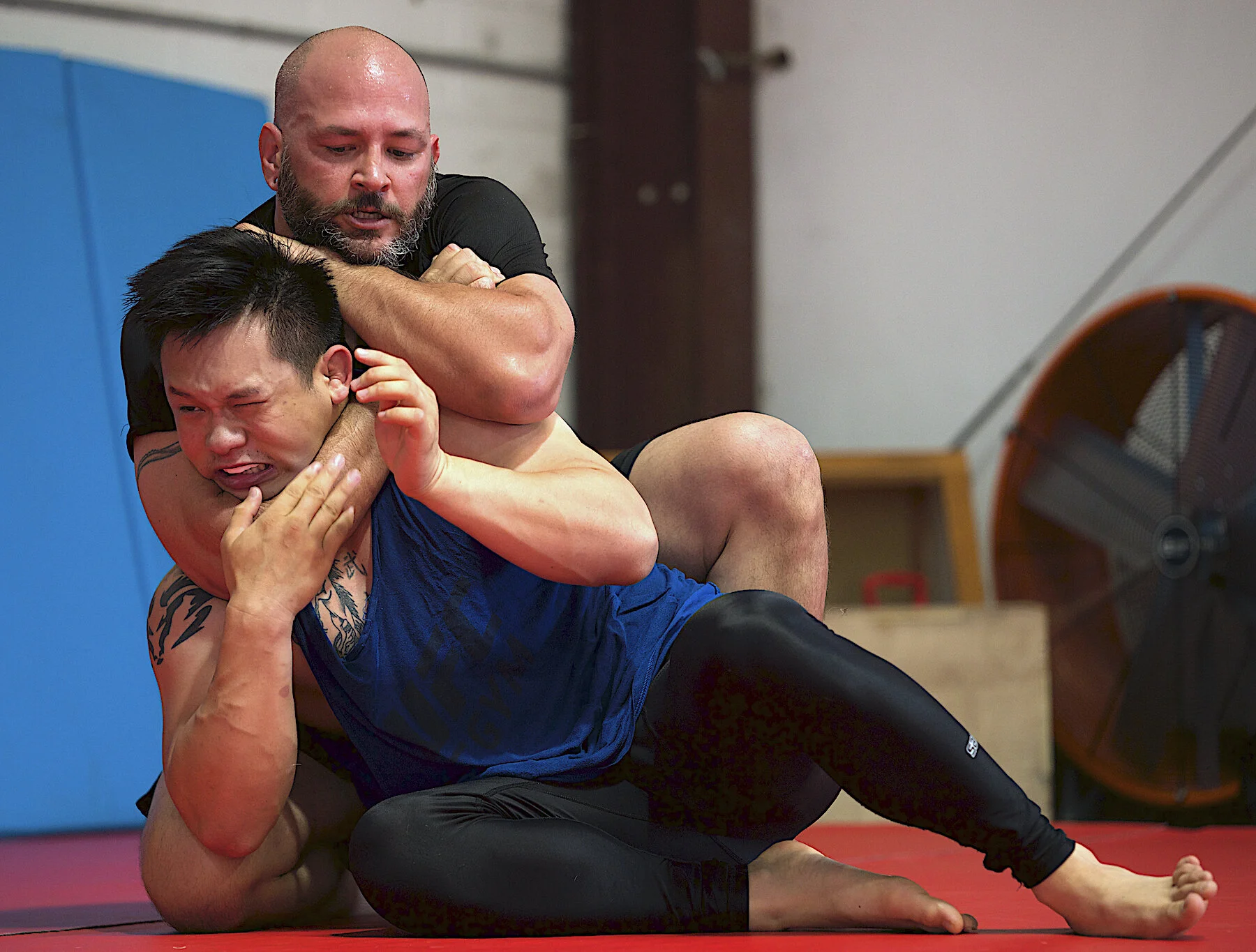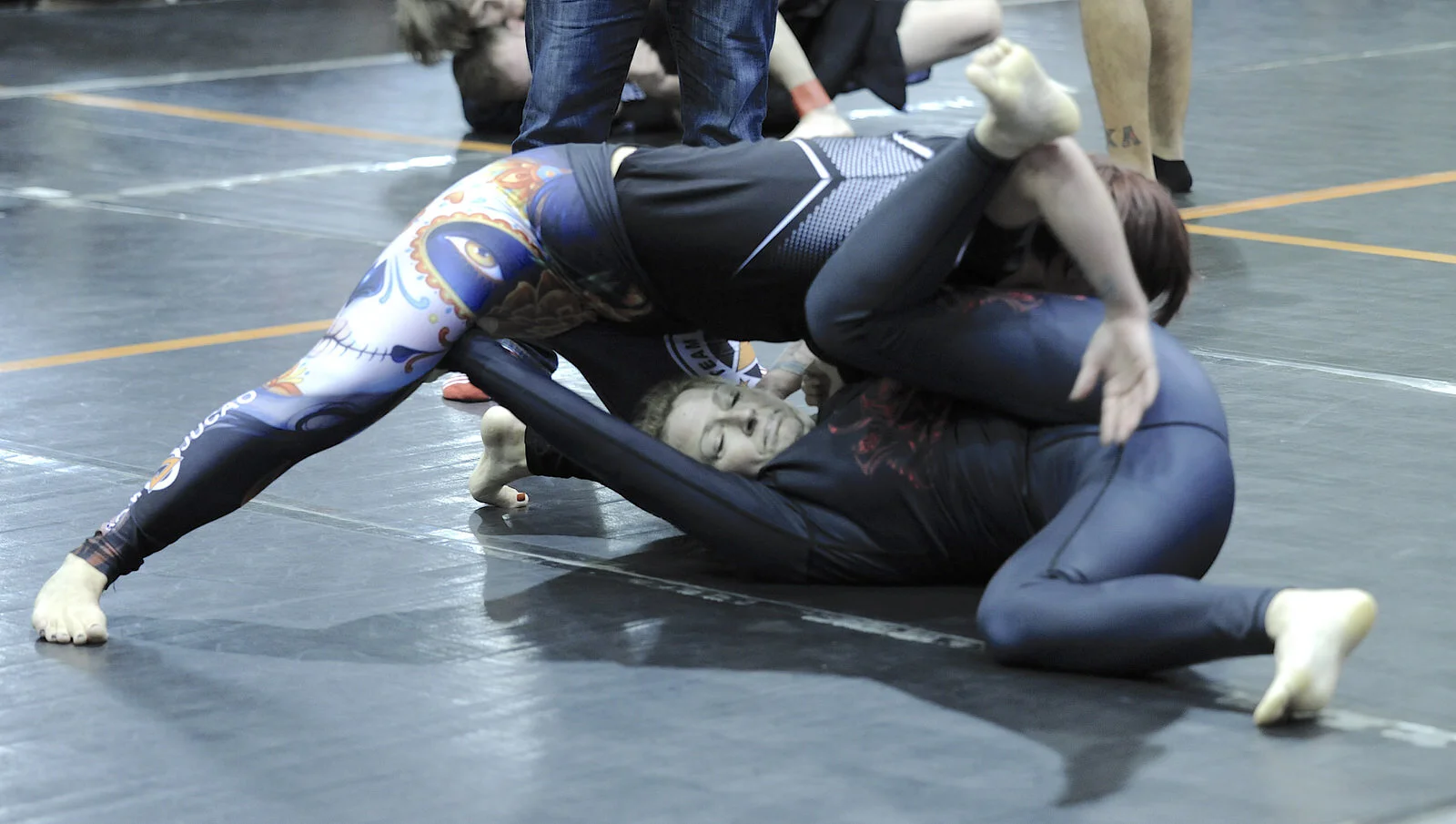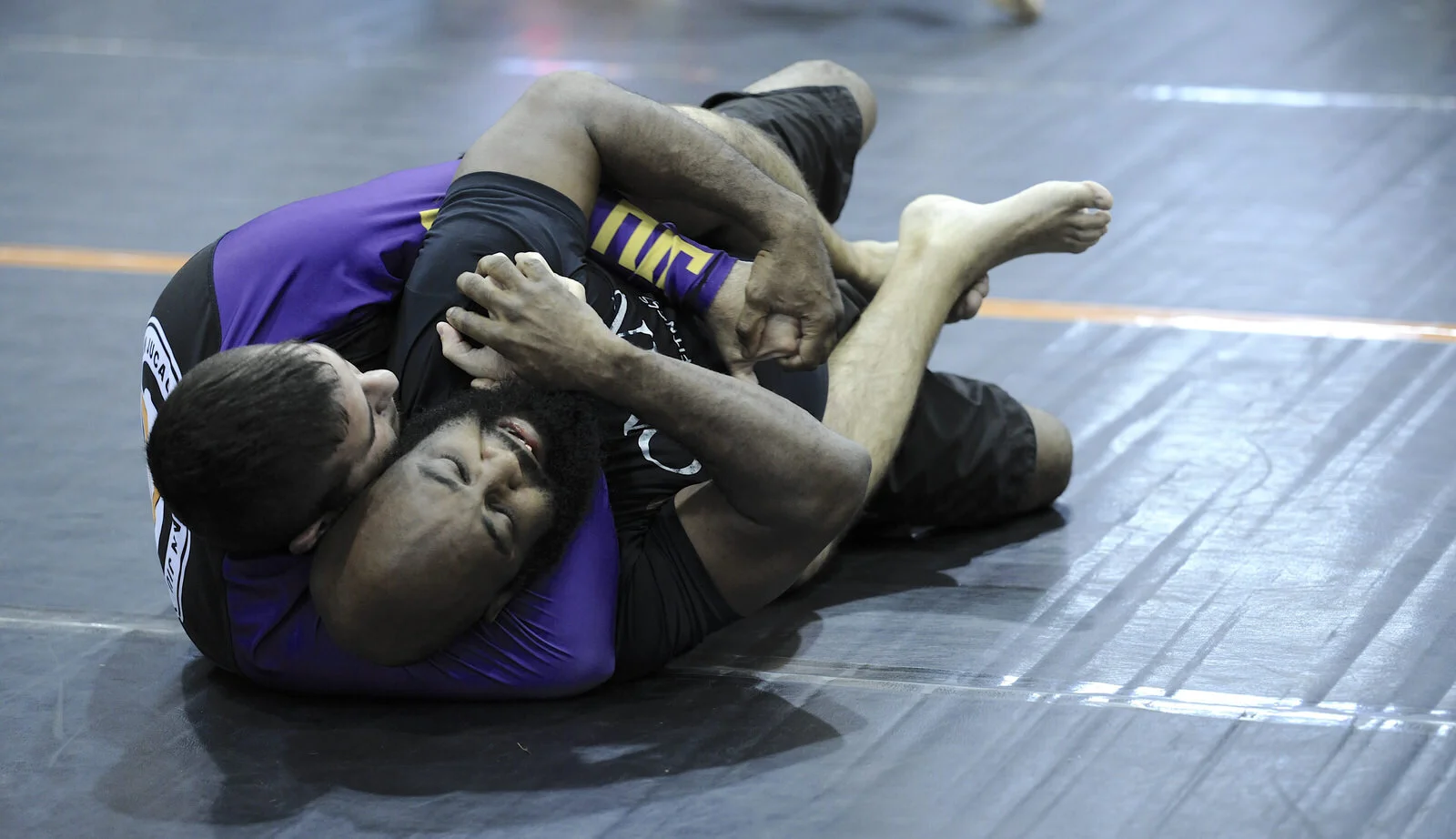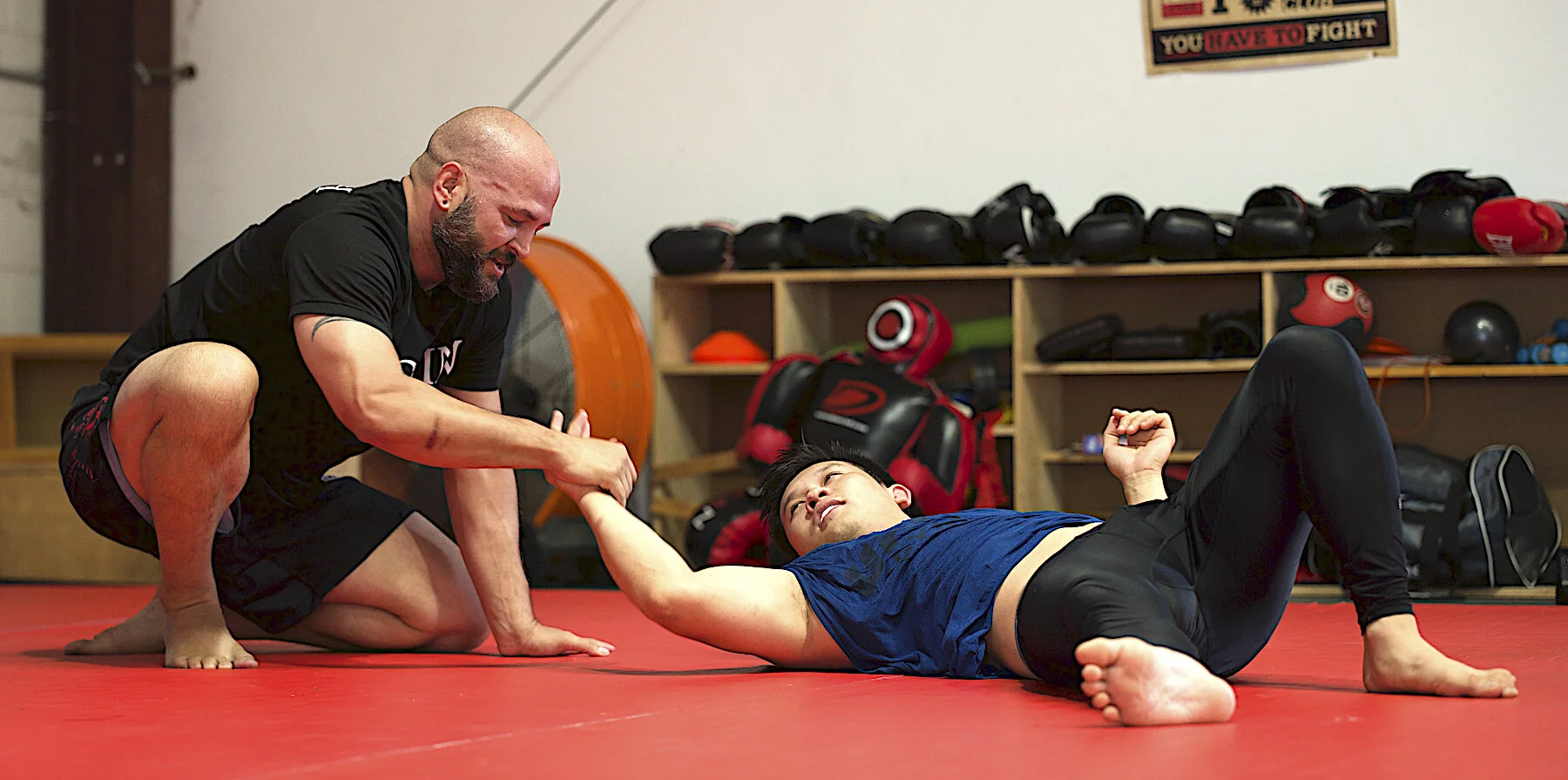6 Mistakes New Grapplers Make [Psychological Training Tips for Beginner Competitors]
We all know that to perform well in any sport, athletes must practice. Physical training is mandatory for participation because if you don't practice it, well, then your body has no idea how to do it.
But even with all the training and physical preparation in the world, you still never seem to be able to shake those performance jitters at grappling tournaments. And after every competition, you find yourself replaying your matches over and over, beating yourself up because you know you could have done better. You've drilled those sequences before; you know how to escape that one hold.
So, why didn't you?
Before we delve into the common mistakes new grapplers make that lead to these performance blunders and tips on how to overcome the anxiety of competition to dominate your opponent, let's take a step back and talk about training.
And by training, I mean mental training. Because that's what this is really all about.
The Importance of (All Types of) Training
Sport and athlete development has always emphasized the physical, tactical, and technical aspects of human performance enhancement for the mastery of both training and competitive tasks; but, scientific evidence also underscores the significance of psychological preparations to optimize the benefits of training as well as help athletes attain superior levels of sport proficiency [2,7].
So, what does this mean?
It means that mental training is just as important as physical training in any sports program.
This is especially true for martial artists, whose sports involve high degrees of technical knowledge combined with exceptional levels of athletic abilities.
But the essence of combat sports, which includes various grappling disciplines like Brazilian jiu jitsu (BJJ) and judo, adds another layer to the ever-complex nature of martial arts- that is the direct physical contact with an opponent where the goal is to attack and dominate the other person, potentially risking pain and injury for either party.
And, not to mention, both physical and psychological discomfort.
Psychological Skills Training (PST)
Mental training programs are typically referred to as psychological skills training or PST plans (in the world of sports psychology), and, according to Heil & Zealand [5] and Suinn [9], they have some specific objectives:
Increase psychological abilities and mental workings
Facilitate correct athletic responses under various situations
Promote behavioral changes
Combined, these goals all improve performances because they help athletes (like grapplers) better adapt within a dynamic world, both inside and outside of a sports context [11]. After all, the mind and body are inextricably linked, so psychological skills also serve as life skills, creating healthy coping mechanisms that enhance overall wellbeing and quality of life in addition to peak sports performance.
6 Common Mistakes New Grapplers Make
As soon as you step onto the mat at a BJJ tournament, you feel those butterflies start rapidly fluttering in your stomach to the point where it makes you nauseous. Your palms start sweating and your heart is beating so fast and loud that you're sure the ref (and your opponent) can hear it as you step forward to begin. At the same time, you're flooded with waves of self-doubt and you worry if you're even ready to compete against the person standing in front of you. They look way more experienced than you...
Sounds familiar?
If so, you're not alone! But you also might be making one (or more) of these common mistakes that are preventing you from feeling confident in your grappling abilities and performing at your absolute best:
1. Over- or Under-training
We've all heard that too much of a good thing is bad. The same concept applies to training. You want to make sure you are prepared- physically and mentally, but you also don't want to burn yourself out or risk injury.
TIP: Be smart about your approach to training. Work with your coach and plan out your sessions, especially in the week leading up to a tournament. Developing a periodized training program is beyond this particular article, but just make sure to listen to your body and schedule recovery days. Sometimes the biggest advantage we can give ourselves is the chance for our muscles to recover through sleep, proper nutrition, and rest days.
2. Focusing on Winning
Winning is important- no one is undermining a goal of taking first place and walking away with gold. But. Focusing on that win during the tournament is more likely to result in a disappointing loss.
Ironic, no?
TIP: Try not to preoccupy your thoughts on "winning." Instead, direct your focus on the techniques you've been drilling, controlling your breathing, staying calm, and defending tight [10]. Competition should be seen as a tool to get better. A learning experience. Making performance goals is a more practical and effective strategy to improve your abilities over time.
3. Under- or Overestimating One's Opponent
It is unwise to under- or overestimate your opponent. It's great that you've been training and are feeling confident in your grappling. But chances are high that your opponent has also been training and is just as confident that they will defeat you.
TIP: Research your opponent (if you know who it is in advance), and manage your expectations. You want to keep a healthy balance between respecting your opponent's abilities while remaining optimistic about your odds. All the while remembering that your experience, whether good or less-than-desirable, will make you a stronger grappler if you let it.
4. Not Regulating Breathing
Breathing is essential; there's no debating that! And athletes are frequently reminded to breathe to help regulate nerves, anxiety, and stress. Van Boom [10] notes that jiu jitsu requires physical and mental coordination, which is impossible to accomplish if you're highly stressed and adrenalized.
TIP: Practice different breathing techniques (which we cover a little later in the article) to keep yourself calm and in control. And remember to breathe out when taking deep breaths, too!
5. Not Reviewing Competition Rules
For some, it may seem like common sense, but if you're new to the competitive grappling world, it may not be so intuitive. Many BJJ tournaments take place under IBJJF rules, which are super important to know. As Van Boom [10] stated in an article about preparing for BJJ competition, not all matches end with a submission. So, if two equally skilled grapplers go to a points decision, whoever understands the rules better (and thus understands how to strategize, using the rules to work in their favor), will probably win.
TIP: Different positions and holds score differently, which should affect your overall strategy, both offensive and defensive. Work with your coach and know the difference between what's allowed in Gi versus No Gi competitions.
6. Going Too Hard, Too Fast
Ah, the dreaded adrenaline dump. Many times new grapplers go all out from the very beginning, attacking their opponent with everything you got. You might even get close to a submission.
And then...
You're done. Drained. You have nothing left.
And then you lose the match.
TIP: It's important to learn how to pace yourself and keep a momentum similar to what you do when free rolling/training. Why? Because during training, you are relaxed and in your element, and chances are, you're body does what you want it to do and you perform better. You want to keep your cool under pressure, reserve your strength, and control the effort you exert throughout the match.
5 Areas to Focus on to Improve Tournament Performance [+ Examples of Tools & Techniques to Help]
Several psychological areas are central to optimal athletic performance. While every grappler is different and has unique needs specific to his or her technical abilities, personality, and experience, focusing on these areas will undoubtedly help practitioners reach their goals and experience more consistent (and improved) performances in future BJJ tournaments.
Here are several examples:
1. Awareness
Self-awareness relates to an athlete's ability to check-in with his or her emotional state and thought processes to self-regulate and gain control of situations to maximize performances [8]. Being self-aware means being able to notice fluctuations in muscle tension, body positions, thoughts, and emotions to conserve energy and execute seamless performances, even under situations of higher arousal and stress.
Keep a journal as a record of thoughts, feelings, and experiences as you train in preparation for BJJ tournaments.
Use your journal as a method of reflection after competing to capitalize on experiential knowledge gained from your performance.
Practice using "The R's" - a process centered on responsibility, recognition, release, regrouping, refocusing, readiness, and response.
Use imagery to gain awareness of ideal performance states, with particular attention given to specific feelings, arousal levels, thoughts, muscular tension, and attentional focus.
Use wearable technology during the day, during training, and simulated competitions to monitor heart rate and gain insight into physical reactions to pressure and stressful stimuli. This also helps you distinguish between arousal that indicates readiness to perform and negative anxiety that inhibits peak performance.
2. Mindfulness
Mindfulness is one of those hot button keywords that seem to spark a lot of debate. However, all mindfulness really involves is the nonjudgmental observation and awareness of one's experiences in the present moment- something that is associated not only with increased overall wellbeing and health but also enhanced sport performance [6]. Increasing mindfulness abilities helps alleviate those troublesome feelings of doubt and other negative thoughts, allowing grapplers to move with automaticity and self-assurance as well as reproduce those effortless, fluid movements that are more often accomplished during training and free rolling sessions.
Perform body scans while laying down to improve awareness of bodily sensations and learn to maintain concentration on an individual task. The goal is to sustain focus on specific body parts and recognize, acknowledge, and feel any sensations that may or may not be in that area.
Conduct deep breathing exercises with intention and focus to learn how to use breath as an anchor during times of stress, arousal, and anxiety. Examples of breathing tasks include:
Diaphragmatic breathing,
Sighing upon exhalation,
Rhythmic breathing,
Concentration breathing, and
Breathing with a 1:2 ratio or a 5-to-1 count [3].
Practice sitting meditation, where you focus is on your breath, sensations in your body, and the open, accepting acknowledgment of any passing thoughts.
Practice walking meditation, where concentration lies on the act of walking, recognizing the complexity of the act, the effort that goes into balancing, isolated movements of body segments, or the motion of your body in its entirety.
Execute basic movement-specific exercises, such as grappling drills, in which your complete attention is given to the task, noticing nuances to movement patterns and bodily sensations in addition to accepting where abilities are that day.
Complete heightened focus drills that encourage stepping outside comfort zones by training under conditions that impose new stimuli, such as loud, distracting music, complete silence, or with the lights turned off.
Write down experiences in your journal, recording all feelings and emotions that arise during mindfulness exercises.
3. Confidence
Confidence is one of the most consistently reported traits correlating to successful sports performances (in addition to being paramount to overall human functioning) [4]. In martial arts, confidence often can fluctuate between high and low levels, especially in a tournament context. It's here when athletes can be burdened with apprehension, uncertainty, and self-doubt, which not only leads to dwelling on what could potentially go wrong, but also hinders grapplers from competing at one's personal best.
Create weekly goals that are both appropriately challenging and lead to mastery experiences to increase feelings of self-efficiacy.
Use your journal to create a success list and a self-esteem list that emphasize positive traits and past accomplishments to illustrate personal ability subjectively and objectively.
Use your journal as a self-talk log to identify patterns in thought processes and recognize instances of irrational or distorted thinking.
Practice in various self-talk exercises, including:
Thought stoppage,
Countering,
Reframing,
Cognitive restructuring, and
Altering the vocabulary from a negative tone to one that results in a more positive expression of thought.
Construct affirmation statements that are vivid, believable, and reflect positive attitudes about yourself.
Perform imagery to re-create past successful performances along with the positive feelings associated with each victory.
Use imagery to practice grappling sequences in addition to playing out the ideal performance against an opponent; vivid, poly-sensory thoughts can trigger, and thus strengthen, the same neural pathways and corresponding muscle pattern activity as physical training [1].
4. Attentional Control
Superior attentional focus is crucial to general peak performance, but is also vital to martial arts competitions due to the considerable physical and mental demands of the sport. BJJ practitioners must be able to practice selective focus- paying attention to important environmental cues while ignoring distractions. Additionally, grapplers must anticipate opponent's actions, make fast decisions, and quickly adapt and automatically respond to changes in performance demands [1].
Simply put, athletes must be able to remain in flow-like states instead of becoming over-analytical and conscious about grappling strategies or trying to deliberately control movements (which usually triggers indecisiveness and hesitation). Lapses in concentration also foster fear, self-doubt, and worry, contributing to a vicious cycle of anxiety and distraction.
Refer to previously written goals or establish separate short-term goals to stay on track with training and improve one element of performance at a time.
Use imagery and mental rehearsal to create high stress and external distractions typical of grappling competitions while at the same time visualizing proper concentration and optimal performance under those conditions.
Create attentional cues and triggers that are visual, verbal, or kinesthetic (relating to body movement) to direct and refocus concentration on task-relevant stimuli.
Utilize your journal as a self-talk log to develop awareness surrounding your internal dialogue and reduce self-doubts and competitive anxiety for more congruence between your attentional focus and peak performance.
Participate in mindfulness acts, such as sitting quietly and focusing on a single thought for as long as possible both inside and outside of the sports environment.
Develop pre-performance routines (PPR) and mental plans to help optimize psychological (and physical) readiness. These practices establish positive rituals and regulate good habits, which help to prevent external stimuli normally encountered at BJJ tournaments from impeding your ideal performance:
Pre-competition; early-, middle-, and late-event; and post-competition strategies,
Refocusing plans, and
Backup plans [1].
5. Arousal & Anxiety Control
Arousal is a general physiological and psychological phenomenon that relates to the autonomic nervous system's response to stressful stimuli. Arousal can also describe an individual’s overall physical and mental state regarding readiness to perform. While not inherently negative or positive, arousal is typically associated with situation-specific competitive anxiety, which manifests as worrisome thoughts, negative expectations, apprehensions about performance, muscular tension, increased heart rate, perspiration, and butterflies in the stomach [3]. Related to arousal and anxiety is also the concept of stress, which involves the relationship between environmental demands, our perceptions of demands, the stress response, and behavioral consequences.
Use your journal to record thoughts, feelings, emotions, and perceptions in connection with training, tournaments, and other life events. These reflections can help uncover patterns of functional relationships between emotions and performance as well as where along the continuum of optimal zones your arousal levels should fall to elicit your best performances.
Use your journal to identify potential stressors and typical responses to situations where you perceive situational demands exceed your available resources (both internal and external).
Actively seek information regarding the stressors you're faced with- like familiarizing yourself with an opponent's tactics and previous performances, to reconstruct perceptions and appraisals as less threatening.
Use your journal to problem-solve. Identify what is causing incidents of high stress, arousal, and anxiety; break the problem down and describe all elements; decide what you want out of the situation; list all viable solutions; explore all possible consequences; and finally, set the course!
Practice various breathing exercise:
Complete, diaphragmatic breathing,
Sighing upon exhalation,
Rhythmic breathing,
1:2 ratio breathing,
5-to-1 count breathing, and
Concentration breathing.
Perform progressive relaxation (PR), which teaches awareness and sensitivity to both the presence of muscular tension and the absence of tension.
Execute momentary muscle relaxation exercises:
Quick body scans,
Neck and shoulder checks, and
Sport muscle checks.
Visualize (using poly-sensory imagery), being in an environment that promotes relaxation.
Recreate symptoms equated with anxious thoughts and feelings, explicitly appertaining to BJJ tournaments, then rationalize and restructure symptoms via self-talk.
Work through the four processes of the COPE model, which are controlling emotions, organizing input, planning the next response, and quickly executing the next task or skill
Deep breathing
Positive self-talk, and
Differentiating between meaningful and irrelevant information [1].
Key Takeaways
Grapplers need to be tough. Physically and mentally. And while PST plans should be individualized to accommodate the unique needs and goals of each athlete, there are some general approaches that can (and should) be taken to help BJJ practitioners improve their performances, both in training and competition settings.
Does every new grappler make these mistakes? Absolutely not.
Is this an exhaustive list of tips and exercises to help improve mental toughness and combat performance anxiety? Not even close.
But.
It is a good starting point to become a more well-rounded martial artist who can better self-regulate those pesky emotions to dominate his or her opponent and demonstrate superior athletic performances when the time comes.
What about you?
Share your thoughts about psychological skills training and combat sports below!
References
[1] Anshel, M. H., & Payne, J. M. (2006). Application of sport psychology for optimal performance in martial arts. In J. Dosil (Ed.), The sport psychologist’s handbook: A guide for sport-specific performance enhancement (pp. 353-374). West Sussex, England: John Wiley & Sons.
[2] Blumenstein, B., Lidor, R., & Tenebaum, G. (2005). Periodization and planning of psychological preparation in elite combat sports programs: The case of judo. International Journal of Sport & Exercise Psychology, 3(1), 7-25.
[3] Hanton, S., Mellalieu, S., & Williams, J. M. (2015). Understanding and managing stress in sport. In J. M. Williams & V. Krane (Eds.), Applied sport psychology: Personal growth to peak performance (7th ed., pp. 207-239). New York, NY: McGraw Hill Education.
[4] Hays, K., Thomas, O., Maynard, I., & Bawden, M. (2009). The role of confidence in world-class sport performance. Journal of Sports Sciences, 27(11), 1185-1199. doi: 10.1080/02640410903089798
[5] Heil, J., & Zealand, C. (2001). Psychological skills training manual. United States Fencing Association Technical Report (No. 2001-01). Colorado Springs, CO: United States Olympic Training Center.
[6] Hopper, D. (2017). Practical applications of mindfulness techniques in sport (Unpublished Bachelor's thesis). Haaga-Helia University of Applied Sciences, Finland.
[7] Johnson, S. R., Wojnar, P. J., Price, W. J., Foley, T. J., Moon, J. R., Esposito, E. N., & Cromartie, F. J. (2011). A coach's responsibility: Learning how to prepare athletes for peak performance. Sport Journal, 14(1), 1-3.
[8] Ravizza, K., & Fifer, A. (2015). Increasing awareness for sport performance. In J. M. Williams & V. Krane (Eds.), Applied sport psychology: Personal growth to peak performance (7th ed., pp. 176-187). New York, NY: McGraw Hill Education.
[9] Suinn, R. M. (2005). Behavioral intervention for stress management in sports. International Journal of Stress Management, 12(4), 343-362. https://doi.org/10.1037/1072-5245.12.4.343
[10] Van Boom, D. (2020, July 15). How to prepare for BJJ competition. Gracie Miranda. https://graciemiranda.com.au/how-to-prepare-for-bjj-competition
[11] Weinberg, R. S., & Gould, D (2019). Foundations of sport and exercise psychology (7th ed.). Champaign, IL: Human Kinetics.
